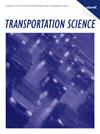从走廊到网络宏观基本图:一种半解析近似方法
IF 4.8
2区 工程技术
Q1 OPERATIONS RESEARCH & MANAGEMENT SCIENCE
引用次数: 0
摘要
为城市地区设计全网交通管理方案或交通政策需要计算效率高的交通模型。宏观基本图(MFD)是一种很有前途的工具。不幸的是,经验mfd并不总是可用的,半分析估计方法需要将网络减少到一个引入大量不准确性的走廊。我们提出了一种半解析的方法来估计现实城市网络的MFD,而不考虑网络减少到廊道所导致的信息损失。该方法基于切割方法,但适用于不规则拓扑的网络,考虑了不同的空间需求模式,并确定了网络流量的上限。因此,我们在网络层面同时考虑流量守恒和溢出效应。我们的框架将给定的网络分解为一组走廊,创建一个超网络,包括源项的影响,然后处理跨走廊的依赖关系(例如,由于转向流和溢出)。在此基础上,导出了MFD的自由流分支和容量分支。通过考虑交通阻塞特征和利用MFD研究的最新进展,对拥堵路段进行了估计。我们在一个基于苏福尔斯网络的现实设置的案例研究中展示了所提出方法的适用性。然后,我们将结果与原始切割方法和从细胞传输模型中导出的基础真值进行比较。这一比较表明,我们的方法在估计网络容量和堵塞密度方面比目前的技术水平精确五倍以上。此外,研究结果还清楚地表明,土地利用对空间需求格局的依赖性。与基于仿真的MFD估计方法相比,该框架的潜力在于建模灵活性、解释性和计算成本的降低。资金:G. Tilg感谢德国联邦数字和运输部(BMDV)对LSS(城市网络容量增加)项目的资金支持。S. F. A. Batista和M. menzendz感谢纽约大学城市网络互动中心的支持,该中心由塔姆肯根据纽约大学研究机构奖[CG001]资助。L. amb本文章由计算机程序翻译,如有差异,请以英文原文为准。
From Corridor to Network Macroscopic Fundamental Diagrams: A Semi-Analytical Approximation Approach
The design of network-wide traffic management schemes or transport policies for urban areas requires computationally efficient traffic models. The macroscopic fundamental diagram (MFD) is a promising tool for such applications. Unfortunately, empirical MFDs are not always available, and semi-analytical estimation methods require a reduction of the network to a corridor that introduces substantial inaccuracies. We propose a semi-analytical methodology to estimate the MFD for realistic urban networks without the information loss induced by the reduction of networks to corridors. The methodology is based on the method of cuts but applies to networks with irregular topologies, accounts for different spatial demand patterns, and determines the upper bound of network flow. Therefore, we consider both flow conservation and the effects of spillbacks at the network level. Our framework decomposes a given network into a set of corridors, creates a hypernetwork, including the impacts of source terms, and then treats the dependencies across corridors (e.g., because of turning flows and spillbacks). Based on this hypernetwork, we derive the free-flow and capacity branch of the MFD. The congested branch is estimated by considering gridlock characteristics and utilizing recent advancements in MFD research. We showcase the applicability of the proposed methodology in a case study with a realistic setting based on the Sioux Falls network. We then compare the results to the original method of cuts and a ground truth derived from the cell transmission model. This comparison reveals that our method is more than five times more accurate than the state of the art in estimating the network-wide capacity and jam density. Moreover, the results clearly indicate the MFD’s dependency on spatial demand patterns. Compared with simulation-based MFD estimation approaches, the potential of the proposed framework lies in the modeling flexibility, explanatory value, and reduced computational cost. Funding: G. Tilg acknowledges support from the German Federal Ministry for Digital and Transport (BMDV) for the funding of the project LSS (capacity increase of urban networks). S. F. A. Batista and M. Menéndez acknowledge support from the NYUAD Center for Interacting Urban Networks (CITIES), funded by Tamkeen under the NYUAD Research Institute Award [CG001]. L. Ambühl acknowledges support from the ETH Research Grant [ETH-27 16-1] under the project name SPEED. L. Leclercq acknowledges funding from the European Research Council (ERC) under the European Union’s Horizon 2020 research and innovation program Grant [646592 - MAGnUMproject]. Supplemental Material: The e-companion is available at https://doi.org/10.1287/trsc.2022.0402 .
求助全文
通过发布文献求助,成功后即可免费获取论文全文。
去求助
来源期刊

Transportation Science
工程技术-运筹学与管理科学
CiteScore
8.30
自引率
10.90%
发文量
111
审稿时长
12 months
期刊介绍:
Transportation Science, published quarterly by INFORMS, is the flagship journal of the Transportation Science and Logistics Society of INFORMS. As the foremost scientific journal in the cross-disciplinary operational research field of transportation analysis, Transportation Science publishes high-quality original contributions and surveys on phenomena associated with all modes of transportation, present and prospective, including mainly all levels of planning, design, economic, operational, and social aspects. Transportation Science focuses primarily on fundamental theories, coupled with observational and experimental studies of transportation and logistics phenomena and processes, mathematical models, advanced methodologies and novel applications in transportation and logistics systems analysis, planning and design. The journal covers a broad range of topics that include vehicular and human traffic flow theories, models and their application to traffic operations and management, strategic, tactical, and operational planning of transportation and logistics systems; performance analysis methods and system design and optimization; theories and analysis methods for network and spatial activity interaction, equilibrium and dynamics; economics of transportation system supply and evaluation; methodologies for analysis of transportation user behavior and the demand for transportation and logistics services.
Transportation Science is international in scope, with editors from nations around the globe. The editorial board reflects the diverse interdisciplinary interests of the transportation science and logistics community, with members that hold primary affiliations in engineering (civil, industrial, and aeronautical), physics, economics, applied mathematics, and business.
 求助内容:
求助内容: 应助结果提醒方式:
应助结果提醒方式:


